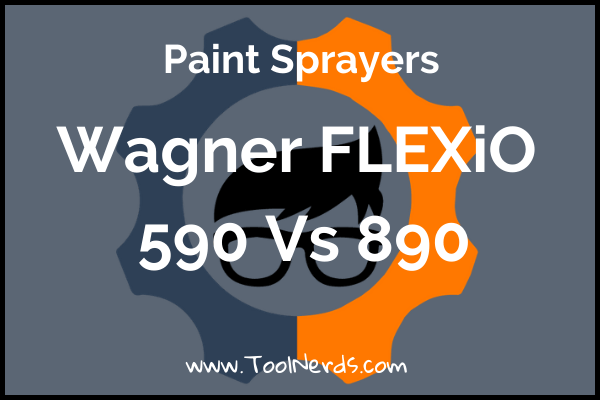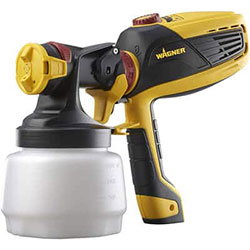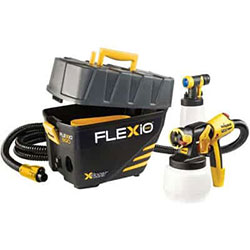Welcome to round one in the Wagner FLEXiO 590 vs 890 bout.
So, a manufacturer launches two separate units, and it feels like you need a degree in decorating to identify the difference between them.
At first glance, the only blatantly obvious variation is that the 590 is a handheld unit, and the 890 has a separate standalone turbine — plus a slight difference in cost.
Both HVLP units are designed with DIYers and home improvers in mind. Simplicity is another similar trait when it comes to operating the two devices — and the burdensome task of cleaning has also been streamlined.
But, some determining factors do set these sprayers apart.
In a nutshell, the 590 sits mid-range in the FLEXiO series. It’s a unit that can handle a diverse range of home improvement projects — from medium size to the finishing touches.
The FLEXiO 890 is one model up from the 590 — its capability matches like for like tasks, but provides higher rates of coverage and a fatigue-busting design.
Take a ringside seat and join me to find out if there is a clear champion — and why.

Included Nozzles
The split gun technology in the FLEXiO 590 is like having two guns for the price of one. Firstly — the iSpray nozzle. It copes with all your heavier mediums and larger jobs — without the need to thin your chosen paint. This makes for a more efficient machine — allowing you to crack on with the task at hand. Secondly — the Detail Finish nozzle. This is ideal for when you need to add finishing touches or complete more intricate work — helping you accomplish those smaller jobs, such as door frames. Both nozzles are painless to change over, due to the Lock-N-Go technology — a simple twist on the front end, and you’re done. This uncomplicated design also allows for easier cleaning. And, the unit can also be adjusted to either spray horizontally and vertically — making it extremely versatile for different projects.
X-Boost Technology
When it comes to having complete control and achieving the finish you were intending, the X-Boost technology comes into play. The X-Boost turbine drives an operating pressure of three PSI, allowing a spray rate of up to 8 gallons per hour — which (as Wagner says) equates to painting a wall 10 times faster than going old-school with a brush. However, with the FLEXiO 590 being a handheld design, the turbine is integrated into the sprayer body. This does make the actual unit weight in your hand heavier than the FLEXiO 890. The X-Boost technology continues in the form of a power dial — enabling you to control the air pressure generated by the turbine. With nine settings, it allows you to tailor the spray gun to different coatings — from thinner stains through to thicker latex — so you accomplish optimal results for your project. To achieve better control and your desired finish with less overspray, simply turn the power down for less viscous paints and crank the power up for denser materials.
Storage
Putting away at the end of the day is a convenient affair — the FLEXiO 590 has it’s very own toughened storage case. Not only does this protect it from dust and detritus gathering, but also knocks and bumps when transporting the unit.
Paint Cup
Each nozzle is accompanied by its own paint cup, and both paint cups are a different size. The iSpray nozzle has a capacity of 1.5-quart (1419 ml), which is adequate to cover the size of a small shed in one go. The Detail nozzle has a smaller 0.63-quart (600 ml) container. This is ideal for completing more complex tasks — it makes the entire unit more compact, ideal for accessing tight spaces.
Who Should Use the Wagner FLEXiO 590?
Capable of completing a range of projects on the strength of the Detail and iSpray nozzles. This is an excellent sprayer for DIYers with a desire to cover midsize and small surfaces — from garden decking to cabinet doors. However, when loaded with paint, plus the weight of the unit, some may find the 590 on the heavy side for larger, lengthy tasks.
Pros of the FLEXiO 590
- Spray rate of 8 gallons per hour.
- Suited for small and midsize projects.
- Copes with stains through to latex — without thinning.
- Durable storage case.
- Includes two nozzles — for detail work and larger surfaces.
Cons of the FLEXiO 590
- May prove too heavy for longer duration tasks.
- Is being replaced by the FLEXiO 3000.
Included Nozzles
Just the same as the FLEXiO 590, the 890 also includes two separate nozzles — the Detail Finish and the iSpray. Consequently, it’s also ideal for a multitude of jobs and uses — with stains, sealers, lacquers, oil-based primers, and latex — without thinning. The settings may also be adjusted to provide horizontal, vertical as well as wide and narrow patterns.
X-Boost Technology
The power dial and turbine are once again connected by X-Boost technology. Although, in this unit, the turbine is a separate entity. Integrated into the storage housing, the turbine is based on the ground. As the bulk of the weight is on the floor, the business end of the machine has an overall lighter feel. This reduces the chance of tired hands and arms. However, you can still achieve sufficient reach with this sprayer, thanks to the 11.5-foot air hose, which connects the X-Boost base and spray gun. This turbine also offers a bit more bang for its buck. It yields an operating flow rate of 8.4 gallons per hour — meaning that you can complete projects somewhat faster than with the FLEXiO 590. The power dial takes a minimalistic approach, with no series of numbers displayed (unlike some of the other models in the FLEXiO range). To adjust the power level, turn the dial to the thinnest part of the marking — and you guessed it, as you turn the dial to where the marking widens, the power goes up.
Storage
This is where the difference clearly becomes apparent between the Wagner FLEXiO 890 vs 590. As I mentioned earlier in this review, the turbine is housed separately in a floor-standing box, which cleverly doubles as a storage case. It’s large enough to fit all the components of the 890 in one convenient place — protecting from the elements and preserving your machine.
Paint Cup
Once again, the FLEXiO 890 also includes two cups — owing to the split gun feature. A smaller 0.63-quart (600 ml) container with the Detail nozzle and 1.5-quart (1419 ml) to partner the iSpray. Between the two, you can handle large and small projects without the need to refill the cup too often. The cups are also opaque, allowing you to keep track of exactly how much paint you have remaining.
Who Should Use the Wagner FLEXiO 890?
As we’ve established, the FLEXiO 890 is a next level sprayer when compared to the 590. If you’re content with the 590 but want a slightly faster spray, the 890 is a great choice. Because of the separate turbine lightening the load, the 890 is also a fantastic option if you’re in your golden years — or intend to take on time-heavy tasks where fatigue could rear its head.
Pros of the FLEXiO 890
- Delivers 8.4 gallons per hour.
- Separate spray gun from the turbine.
- Horizontal and vertical spray patterns.
- 11.5-foot hose.
- Includes two paint cups.
- Sprays unthinned coatings from stains through to latex.
Cons of the FLEXiO 890
- Louder than some other sprayers.
- Being replaced by the FLEXiO 5000.
- Many similar features when compared to the lower cost of the FLEXiO 590.
Wagner 590 vs 890 Comparison Table
| FLEXiO 590 | FLEXiO 890 |
|
|---|---|---|
| Handheld | ✓ | X |
| Storage Case | Separate | Integrated |
| Project Size | Small to midsize interior and exterior. | Small to midsize interior and exterior. |
| Spraying Mediums | Stains, sealers, water-based lacquers, polyurethane, oil enamels, latex, and primers. | Stains, sealers, water-based lacquers, polyurethane, oil enamels, latex, and primers. |
| DIY | ✓ | ✓ |
| Delivery rate (gallons per hour) | 8 | 8.4 |
| Speed (vs brush) | x 10 | x 12 |
| Operating Pressure | 3 PSI | 3 PSI |
| Nozzles Included | 2 | 2 |
Conclusion
With so many shared features — number of nozzles, job size, and medium usage — a clear knockout blow hasn’t materialized. So, the FLEXiO 590 and the FLEXiO 890 need to go to the cards.
In my estimation, the 890 sneaks in front to claim the win.
The separate turbine combined with the 11.5-foot hose makes spraying sizable projects less tiresome in the arm department. Furthermore, the enhanced delivery rate of 8.4 gallons is ideal if you’re seeking rapid coverage.
However, the 590 isn’t inadequate by any stretch of the imagination and could appeal to DIYers with occasional use in mind. It still takes care of a wide range of mediums without thinning and delivers different spray patterns over intricate and vaster projects — on account of the split gun technology.
But there can only be one vanquisher in the Wagner FLEXiO 590 vs 890 tournament and as the 890 claims the belt — I suggest checking out this lightweight champion here.
Wagner FLEXiO 590 vs 890 FAQ
Q: What Is the Difference Between Wagner FLEXiO 590 and 890?
The FLEXiO 590 is a handheld unit with a built-in turbine, whereas, the 890 has a standalone turbine cleverly integrated into a storage case. This makes the front end of the 890 more lightweight to handle. What’s more, the FLEXiO 590 has a slightly lower delivery rate of 8 gallons per hour compared to the 8.4 gallons per hour of the FLEXiO 890.Q: How Long Can You Leave Paint in a Wagner FLEXiO 590 and 890 Sprayer?
Most pro painters recommend cleaning your sprayer after each use to guarantee the longevity of your machine. Leaving unused paint in your unit can lead to the medium congealing and making it more difficult to clean in the long run — therefore damaging the sprayer. As both the FLEXiO 590 and 890 possess simple, pull-apart components, cleaning is a straightforward affair. Hence, there should be no need to procrastinate when it comes to this arduous yet necessary task.Q: Do You Need To Thin Paint for Wagner FLEXiO 590 and 890 Sprayers?
When using the iSpray nozzle in the FLEXiO 590 and 890 paint sprayers, you don’t need to thin thicker coatings like latex interior and exterior mediums.Q: Are Wagner FLEXiO 590 and 890 Spray Guns Any Good?
The Wagner FLEXiO 590 and 890 are affordable have-it-all HVLP sprayers tailored for DIYers. Both are capable of covering small to midsize projects with decreased overspray. The two different nozzles — the iSpray and the Detail Finish — offer versatility in that you can accomplish a project consisting of vast spraying and intricate work with the one machine. They both include robust storage cases — protecting the units during transportation and when not in use. The duo also handles most paints that the average home improver uses — stains, oil-based primers, enamels, plus interior and exterior latex.Q: Is an Airless or HVLP Paint Sprayer Better?
An HVLP (high-volume, low-pressure) sprayer will typically produce more uniform, smaller atomized particles — meaning less overspray than an airless sprayer. However, HVLP sprayers are suited towards smaller, more intricate tasks, whereas airless machines are geared for larger, high-volume projects.Q: How Much Does the Wagner FLEXiO 590 Paint Sprayer Cost?
The FLEXiO 590 is a handy sprayer that works well for use on detailed work like cabinet doors — and larger surfaces such as interior walls. For the most up-to-date price, take a look here.
Q:What Is the Current Price of the Wagner FLEXiO 890?
Showcasing a turbine that’s housed separately from the actual gun, the FLEXiO 890 is a lightweight option for those home improvers with a multitude of spray projects to complete. Check out the price here.














